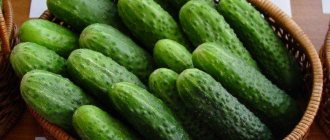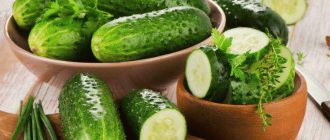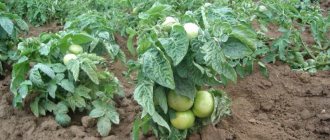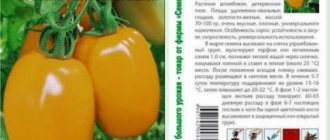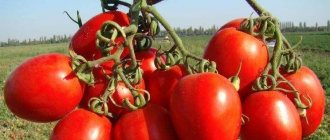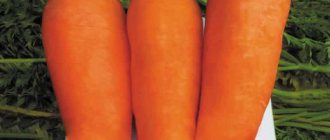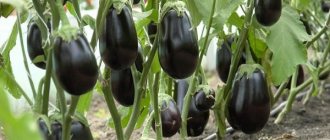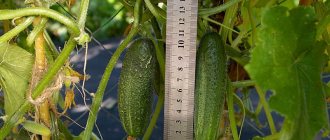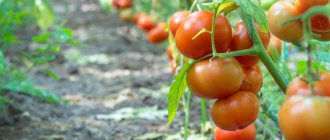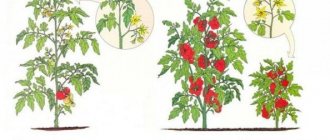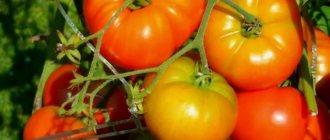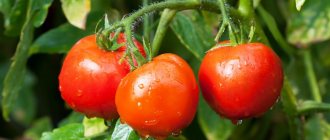General information about the variety
The bush cucumber was bred in the Krasnodar region about 40 years ago, but even now, with a huge variety of varieties, it does not lose popularity. It is suitable for almost all regions, and involves cultivation in open ground, with the exception of varieties intended for greenhouses.
Among the varieties for open ground, the most popular are “Dar”, “Korotyshka”, “Mikrosha”, “Kustovoy” and this is not a complete list. After harvesting the fruits, you can independently collect and prepare seeds for planting next year, but no one guarantees their high germination and productivity.
Hybrid or self-pollinating are intended for cultivation in closed ground and are designated F1. It means that the variety appeared through hand pollination or crossing several varieties. Self-pollinating varieties combine the best qualities, so they are more expensive than ordinary ones, but they have one drawback. It is impossible to obtain seeds from ripened fruits. Most often, gardeners plant the following varieties on the plot: “Baby Sturdy”, “Baby”, “Hector”, “Aladdin”, “Boy with a Thumb”.
Important! Hybrid cucumbers have many advantages over their parent varieties; they are more resilient, productive and have excellent taste.
Growing
It should be noted that the agricultural technology of growing cucumbers and the perennial cucumber varieties more familiar to vegetable growers differs little. As a rule, bush cucumbers are grown in most regions of our country in seedlings, which contributes to the earliest harvest, as well as:
- It is recommended to sow cucumber seedlings for 20 days under a temporary film covering.
- A distance of 25-27 cm should be maintained between cucumber bushes. The standard distance between rows should be about 45 cm.
- Cucumbers grow especially well in warm, well-seasoned organic fertilizers. The best soils for growing cucumbers are loamy and sandy loam soils.
- The defining growth type of bush cucumbers is characterized by limited growth of the central stem, and the vegetation ends in the formation of a flower brush.
Expert opinion
Filatov Ivan Yurievich, private farmer for more than 30 years
On average, you can collect about 3-4 kg of such plantings from each square meter. Due to their compactness, shrub cucumbers are in great demand for decorating ornamental gardens. Despite the fact that a lot of effort, time and money will be spent on caring for such plants, the yield of bush cucumbers will not be too high.
Characteristics of a bush, tree, foliage
The bush is lush, the stem is determinate, so its height most often does not exceed 50-70 cm. The leaves are dark green, small in size, located close to each other, so the bush looks deciduous and even decorative, while it is quite compact and does not take up much places. If all care conditions are met, then after each leaf the ovaries of future fruits should form.
It grows as a small bush, and not as vines, due to this it does not take up much space in the garden bed; many gardeners are attracted by this fact. You can plant much more bush cucumbers in the garden than usual. They are suitable for people who have a small area allocated for planting vegetables.
Features of bush cucumber
The characteristics and description of a bush-type vegetable crop are based on the following characteristics:
- The bushes are compact, their lashes reach a length of 50 to 80 centimeters. The shortness of the internodes gives the plant splendor.
- From one square meter of bed you can collect from three to five kilograms of greens. This is not much, but cucumbers can grow quickly, amicably, without getting sick.
- The fruits ripen early, so they are enjoyed at the end of June.
- Greens, small in length and weight, are also suitable for pickling, pickling, and preparing salads.
This type of vegetable is popular among vegetable growers due to its unpretentiousness, high taste, and compactness. But no matter how good conditions cucumbers grow in, large yields cannot be obtained from the bush.
Fruit characteristics and yield
The variety is early, the fruits ripen already on the 46th day after emergence. Cucumbers ripen together, which is convenient for preservation. The weight most often does not exceed 100 g, the fruits are dark green in color with small spines, grow evenly and uniformly in shape. Most often they are small in size, each 8-12 cm long, 4-5 cm in diameter. The skin is dense, but not thick, so the fruits store well for up to 1 week.
Information!
The variety is suitable for preparing salads and fresh consumption, as well as for canning. Rolled cucumbers turn out crispy and dense.
On average, the yield is 2-3 kg per cucumber bush. If planted close to each other, 4 bushes will fit on 1 square meter and in the end you can collect up to 12 kg. But such a yield depends primarily on proper care.
Treat seeds before sowing
| Step 1. Purchase or collect seeds Buy seeds from reputable stores. Germination and productivity largely depend on the quality of planting material. Prepare seeds. Allow a few cucumbers to fully ripen. Then select the seeds and dry them in the sun | |
| Stage 2. Select quality seeds Make a saline solution. Proportions: 1 part salt to 20 parts water. Stir until the crystals are completely dissolved. Place the seeds in the liquid. Leave for 3 to 4 hours. Remove all floating seeds that have settled to the bottom, collect and rinse | |
| Stage 3. Treat the seeds Prepare a solution of potassium permanganate. To do this, a small amount of crystals is added to the water and mixed, the color should be the same as in the photo. Place the seeds in potassium permanganate and let sit for an hour. Remove and rinse. Make a growth stimulator solution according to the instructions. Place seeds in it and keep for as long as recommended by the manufacturer | |
| Stage 4. Sprout the seeds Place a layer of gauze or a cotton pad in a suitable container. Spread the seeds evenly and cover with another layer on top. Moisten thoroughly. Place in a warm place. Water daily, sprouts usually appear within 2-3 days | |
| Stage 5. Harden the planting material Wrap the container with sprouted seeds in plastic. Place in a refrigerator compartment with a temperature of 1 to 5 degrees. Leave for about 18 hours. Then put the seeds in the room for 4-5 hours to warm them up | |
| Step 6. Sow the seeds Buy peat cups. Fill them with ready-made soil for seedlings, plant the seeds to a depth of 1 cm. Water as needed. After germination, place on the windowsill and feed after 3 weeks |
Advantages and disadvantages of the variety
Bush varieties, like other varieties, have a number of advantages and disadvantages, based on which gardeners determine whether a given variety is suitable for them or not. Advantages:
- the fruits ripen quickly, usually this process takes no more than 3 weeks;
- the bush is small in size, so it does not require much space;
- cucumbers have an excellent taste, without bitterness;
- the variety is resistant to various diseases;
- long-term storage of fruits is possible;
- easy care that does not take much time;
- Use both fresh and canned.
Flaws:
- low yield, much less than from climbing bushes;
- short fruiting period, so you need to think through the schedule in advance in order to have a good harvest throughout the summer season.
In general, these disadvantages are compensated by a huge number of advantages, thanks to which gardeners love bush cucumbers so much. The plant does not grow and does not require staking or pinching. They can be planted close to each other, and after harvesting, you can immediately remove the bushes and use the freed area for planting greenery or green manure.
Varieties of bush cucumbers
The names of bush cucumbers reflect their appearance and refer to the small size of the plant. Let's look at the best types of varieties and hybrids.
Among the varietal options
Varietal species allow you to obtain your own seeds for planting.
Bush
It is pollinated by bees, so it is planted in open ground. In warm regions it can be planted from seeds. For areas characterized by spring cooling, seedlings are grown.
From emergence to ripening – 45-50 days. The greens are bright green, juicy, with sparse bumps. Size – 10-12 centimeters.
Tolerates drought and lack of watering well. Cucumbers can be stored for 10 days without loss of quality.
Mikrosha
Bee-pollinated variety. Ripens 45-48 days after germination. The fruits are densely small-tubercular, pronounced green in color.
Consumed fresh, suitable for canning and pickling.
Bush gift
The fruits are ready in 48-50 days from the appearance of friendly shoots. The cucumbers are small - 9-12 centimeters; if harvested untimely, they do not overgrow and do not turn yellow.
See also
Characteristics of cucumbers of the Relay variety, cultivation and yield
Read
The fruits are slightly round in shape, with a slight tuberosity, weight - 90 grams.
Hybrids
Hybrids have a special sign on the packaging - F1. Summer residents should understand that they cannot get seeds from these plants. Hybrid species demonstrate higher yields and are better resistant to diseases and pests. Most summer residents prefer hybrids, since they do not want to deal with seeds themselves.
Baby F1
The baby grows as a small bush, the stem does not grow longer than 30 centimeters. It is considered precocious - it grows in 40 days. The cucumbers are of excellent quality, with rare lumps, length – 9 centimeters. Pollination by insects. Does not become infected with powdery mildew and viral diseases.
Ant F1
Ultra-early ripening - 37-38 days. This hybrid is planted to produce the first cucumbers. The ant belongs to the parthenocarpic type, therefore it is used for growing in greenhouses and at home in containers, and not only in open ground.
The knot produces 2-7 ovaries. The cucumbers are bright, with indistinct whitish stripes reaching to the middle of the green. They have no bitterness. Suitable for any type of use.
The yield is 10-12 kilograms per square meter.
Shorty F1
Grown in open ground, ripening in 49-52 days. The fruits are 9-12 centimeters, triangular-cylindrical when cut. The surface is tuberous. Used fresh and for preparations.
Resistance to diseases and pests, adverse conditions
The plant is resistant to diseases, as it has a short ripening period. At the time when diseases begin to appear on ordinary cucumbers, bush cucumbers can be harvested, so they do not catch this time. But improper care or nearby infected plants can trigger their appearance. Diseases:
- Powdery mildew;
- Different types of rot (brown, gray, white);
- anthracnose;
- peronosporosis;
You should get rid of an infected plant immediately; you should not leave it in the garden, for example, throw it into compost. Neighboring bushes and soil must be thoroughly treated with chemicals to prevent infection of all plants. Pests that can appear on cucumbers:
- spider mite;
- nematode;
- aphid.
To destroy them, you can use folk remedies or insecticides.
Advice!
To prevent the appearance of pests and diseases, you need to treat the soil with copper sulfate before planting.
The best bee-pollinated varieties of cucumbers for open ground
Many gardeners note that bee-pollinated cucumbers are less capricious. There are more of them and they are more diverse, but in return you need to control the pollination process.
Elegant
One of the best varieties in terms of cold resistance became the basis for many later hybrids. A powerful root system ensures the viability of the plant in different conditions.
Competitor
A high-yielding early variety produces bright green fruits up to 12 cm and 125 g. These are universal cucumbers for canning and salads, and also for sale due to their excellent commercial qualities.
Baby
The compact bush variety has weak branches and from a distance generally resembles a miniature zucchini. But it produces very sweet and refreshing fruits with thick, elastic skin.
Parisian gherkin
The old variety has been tested by time and tens of thousands of gardeners. Tall bushes with medium-length vines give an early high harvest. The Parisian gherkin is resistant to drought and disease.
Finger
The early hybrid is valued for its long and stable fruiting, which can last for 2 months. The fruits are recognized by their smooth skin without thorns or thorns.
Features of agricultural technology of the variety
For normal growth, bush cucumbers need loose and fertile soil. Therefore, it is better to plant them in a garden bed where legumes (beans, broad beans, peas), nightshade or cabbage crops previously grew. You should not use a place for planting where there were zucchini, cucumbers or pumpkin. These vegetables have common soil requirements, and therefore common diseases and pests.
Seed selection and preparation for planting
The seeds can have any name, for example, “Baby”, “Shorty”, “Ant”, but in addition to this, the packet must have the inscription bush. Seeds should be purchased only from reliable and well-known manufacturers, otherwise there may be an unpredictable harvest result.
Preparation includes the following steps:
- Germination test. To do this, the seeds need to be immersed in salted water, after that you need to leave those that sank to the bottom, and throw away those that float.
- Disinfection. This can be done using potassium permanganate or other solutions.
- Increased germination. Seeds can be treated before planting with growth stimulating drugs. To do this, they need to be kept in the prepared solution for about 20 minutes.
Soil preparation and sowing
For seedlings, you can use purchased soil mixed with soil from the garden. You can only take garden soil, having first mixed it with humus in a ratio of 5:1, but it should not be contaminated. To play it safe, it is better to disinfect it before use, for example, sprinkle potassium permanganate on the boxes.
The bushes tolerate replanting well, so it is not necessary to plant each seed in an individual cup; to begin with, you can plant all the seeds in rows in one box. Depending on its size, this can be done in 2,3 or 4 rows. It is better to leave a distance of at least 6 cm between the rows, and about 3 cm between the plants. Before planting, the soil must be well moistened, and after planting, the top of the box must be covered with film and removed only before watering. It will increase and maintain a uniform temperature inside.
Care and planting
Usually, cucumbers sprout quickly; after 6 days, the first seedlings should appear. After the first shoots, the film must be removed and the boxes placed in a bright place, while the room temperature should be about 20 degrees. You need to water 2-3 times a week, but you need to monitor the condition of the soil.
After two leaves appear, the seedlings can be planted into pots. And a week after that, additionally feed. Planting in the ground can be done in April-May, after the appearance of 4 true leaves and the soil temperature is at least 18 degrees; before this, additional ash can be poured into the holes. When planting, you need to ensure that the distance between the bushes is no more than 30 cm, and the row spacing is 50-60 cm.
Important!
The variety is bee-pollinated, so it is not suitable for growing in a greenhouse; for this purpose it is better to purchase a self-pollinating variety of bush cucumber.
Seedling care
Cucumber crops do not like it when the soil dries out, so it is recommended to water it once every two days with warm water in the morning or evening. But excessive moisture also has an undesirable effect on the condition of the root system - the roots begin to rot.
On a note! Moisture on leaves can cause sunburn.
When the temperature drops below 16°, you need to stretch a film or covering material over the plantings or place a portable shelter.
Feeding seedlings:
- after the first leaf – 15g of superphosphate, 7g of ammonium nitrate, 8g of potassium sulfate + 10l of water;
- repeat feeding in a double dose after two weeks.
Growing, care, bush formation, pruning features, garters
May be interesting Features of growing the cucumber hybrid “Magnat f1” Planting cucumbers in June 2021: table of favorable days by lunar phases Planting and growing cucumbers under spunbond: advantages of film coatings
The plant can be planted either as seedlings or directly with seeds outside. The only difference will be that the bushes planted with seedlings will bloom and bear fruit a little earlier. After planting plants in the ground, you need to carefully monitor them. After planting, be sure to cover the bed with film, this is done in order to maintain the same temperature and humidity, and this will also protect weak bushes from cold nights.
You need to water with settled water; when watering, you should not overuse it, it is better to do it in portions, making sure that all the water is absorbed first, and only after that add another portion of liquid. A large amount of moisture will provoke the formation of fungal infections and rot on the roots. On average, in warm weather, watering once every 2 days is sufficient. For convenience, you can use drip irrigation; it provides the required amount of moisture to the plant and does not require time-consuming monitoring. It is important to ensure that as little liquid as possible gets on the leaves.
The plant does not require tying or pinching side shoots, as they form small lashes about 0.5-0.8 m long, so the bush does not require shaping.
Important!
If the leaves of cucumbers begin to turn yellow and fall off, then the plant has a lack of nitrogen, so it is necessary to feed it with fertilizers containing it. A purple tint indicates a lack of phosphorus
Advantages and disadvantages
The Bush variety has many more advantages than disadvantages. These can be listed:
- Endurance. The variety is undemanding to soil and tolerates heat, drought, and strong winds more easily than others. It can be planted in remote areas when it is not possible to care for the plant constantly. Although, of course, with more careful care, the yield will be higher.
- Easy care. The plant does not need to be pinched, tied to trellises or formed into a bush. The shoots do not intertwine with each other and therefore they are well illuminated by the sun and ventilated. As a result, the likelihood of developing diseases is reduced. The plant does not require any special feeding, other than those recommended for all cucumbers without exception.
- Early harvest, smooth ripening of fruits. The plant manages to produce its harvest before mid-summer, when some plants begin to develop all sorts of diseases due to heat and humidity. Thus, the risk of losses is reduced.
- Drought resistance. The plant does not need frequent and abundant watering, since its medium-sized wattles evaporate and require much less liquid than other varieties. In dry and hot weather, it is enough to keep the soil under the bush slightly moist.
The main disadvantage of this variety is the inability to grow it in greenhouse conditions. The fact is that Kustova needs bee pollination, and it is difficult to open access for pollinating insects to it while maintaining the microclimate. In addition, Kustovoy is not capable of producing the same rich harvest as modern tall hybrids intended for cultivation in closed conditions.
Cucumbers with a long vine can grow a new vine, on which an ovary will subsequently form, that is, an additional harvest. The bush tree forms the first spring ovaries on its short vine, on which fruiting will end. Therefore, this variety should not be grown by farmers who want to make money by selling vegetables. It is simply not profitable to occupy greenhouse space with them.
Attention!
The bush variety can be planted 2 times per season: first in April, and then in July.
Harvest storage
Cucumbers store well, but for this purpose you need to choose fruits that are not damaged; you cannot wash them either, as this will wash off the natural layer that protects them from rotting. Storage methods:
- Place them in the refrigerator on a plate to keep them fresh for 3 days. In a plastic bag with holes for air, this period increases to 5 days, and if you cover the hole with a damp cloth, up to 10 days.
- In a bowl or jar of cold water in the refrigerator, cucumbers will last 3-4 weeks. It is necessary to place it in a bowl in such a way that a small tail remains and the stalk is in the water all the time, but at a level above a third of the fruit. It needs to be changed every 2 days.
- In a wooden box or cardboard box, shelf life is 3-4 days, but the room temperature should not be higher than 17 degrees. In the cellar, where the temperature reaches 6-8 degrees, it increases to 10 days.
- Wrapped in fresh egg white film. Cucumbers should be coated with protein and left on the shelf in the refrigerator. A protective film is formed on them, which prevents moisture evaporation, so the fruits remain fresh for up to 2 weeks. At the same time, you need to make sure that they are not close to the freezer, in which case they will quickly become soft.
- Cucumbers kept fresh in paper for up to 2 weeks. To do this, you need to wrap them one at a time in paper towels, then in a plastic bag and put them in a cool place.
Cucumbers should not be stored together with overripe vegetables and fruits, as this causes them to quickly begin to ripen, and in a tightly tied plastic bag, without access to air. Regardless of the storage method chosen, you need to select the highest quality fruits, and check them every 3 days and remove damaged and limp ones.
Organization of watering cucumbers
Unlike classic wattle cucumbers, representatives of this crop need abundant watering. For irrigation, settled water is used, heated to air temperature (for this, the container with water is placed in the open sun). There is one more interesting detail.
Note!
How to tie cucumbers in open ground - common mistakes, use of plastic bottles, correct methods with photos
At what distance to plant cucumbers: seedlings and seeds, description of the rules, placement of cucumbers in the garden, planting in a row, in two rows (110 photo diagrams)
Mesh for cucumbers - installation and manufacturing instructions, options for use and application, review of the best designs with photos
For ordinary cucumbers, the top watering method is not used, which can lead to deformation and damage to the leaf.
For bush cucumbers, both soil moisture and leaf irrigation are used. Watering should be done every day, and the method depends only on the preferences of the owner of the garden.
Reviews
Marina, Moscow region:
I use bush cucumbers for canning in jars. The bush takes up little space and saves space well for planting other vegetables. I plant them directly in open ground, they germinate well and grow quickly. The harvest is good, the cucumbers are crispy and small in size.
Polina, Pskov:
I’ve been planting this variety for a long time, mainly for food. Children love cucumbers; they often make salads, lightly salted cucumbers, and simply eat them whole. They are easy to care for; they tolerate heat and drought well, but for good growth, I sometimes feed them with fertilizers. There is no need to tie or pinch, this saves a lot of time.
Main characteristics
Bush plants differ from other types of this vegetation because they take up very little space, only 0.6 to 0.9 m², and have a short stem length, approximately 30-70 centimeters.
Note!
Such cucumbers have weak branching, a large number of ovaries, and their fertility, since all greens become mature in a short time.
Varieties are divided into two large groups according to length and types of stems:
- liana-like stems that tightly fly around any support;
- compact, small vines in small quantities.
